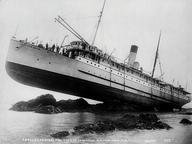Quiz Answer Key and Fun Facts
1. What happened in 1910? Mark Twain and Florence Nightingale died, E.M. Forster wrote "Howards End", China abolished slavery, and something appeared in the sky that hadn't been seen since 1835. What was it?
2. What happened in 1911? Marie Curie won the Nobel Prize for chemistry, Irving Berlin wrote 'Alexander's Ragtime Band', Winston Churchill was named First Lord of the Admiralty, and a painting was stolen from the Louvre in Paris. What famous painting was it?
3. What happened in 1912? The Titanic sank, Arizona and New Mexico became states, the Piltdown Man was found near Lewes in England (and would be proven a hoax in 1953) and the Kuomintang was founded. In which country was the Kuomintang a political party?
4. What happened in 1913? The United States levied the Federal income tax under the 16th amendment to the Constitution, the new Grand Central Station opened in New York City, Harry Brearly invented stainless steel in Sheffield, and the Ford Motor Company introduced an innovation that changed the way industry operated. What was it?
5. What happened in 1914? World War I began (though, of course, it wasn't called that then), James Joyce wrote "Dubliners", St. Petersburg became Petrograd, and an animal named Martha died in the Cincinnati Zoo, marking the end of a species. What was Martha the last of?
6. What happened in 1915? Babe Ruth hit his first home run, the Germans sank the RMS Lusitania, the Raggedy Ann doll was patented, and D.W. Griffith directed a very controversial film. What was this movie that portrayed the Ku Klux Klan in a positive light?
7. What happened in 1916? Pancho Villa raided New Mexico and killed 17 Americans, German zeppelins attacked Paris, Frank Lloyd Wright designed the Imperial Hotel in Tokyo, and the "Saturday Evening Post" released an issue with a particular artist providing the cover for his or her first time. Who was the artist?
8. What happened in 1917? Sigmund Freud wrote "Introduction to Psychoanalysis", Mata Hari was executed as a spy, Mexico adopted its constitution, and three children claimed to see the Virgin Mary in a town in Portugal. What was the town?
9. What happened in 1918? Max Planck won the Nobel Prize for Physics for his work on quantum theory, Montenegro united with Serbia, women over 30 years old got the vote in Britain, and something happened that would kill 25 million people in just six months. What was it?
10. What happened in 1919? Oliver Smith created a mechanical rabbit for greyhound racing, the Black Sox scandal rocked professional baseball, Sherwood Anderson wrote "Winesburg, Ohio", and the 18th Amendment to the U.S. Constitution was ratified. What did the 18th Amendment do?
Source: Author
john_sunseri
This quiz was reviewed by FunTrivia editor
bloomsby before going online.
Any errors found in FunTrivia content are routinely corrected through our feedback system.


